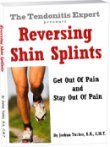Severe Plantar Fasciitis and Foot Surgery at Age 21
by Melissa
(Australia)
I used to be a happy, outgoing and athletic person. I walked 5km's most days for fitness, loved boxing, playing with the kids and was just always on the go from the second I woke up to when I went to bed.
I first developed plantar fasciitis in my right foot in 2001 at the age of 21. At first it was just a niggling pain that went away after a few hours rest.
I didn't really think too much about it at the time because I was only 21 and my job in the Navy meant standing for very long periods of time on hard surfaces.
Eventually the pain became very severe and harder to manage. No amount of ice, rest or pain relief made an ounce of difference.
I kept bringing it up with every doctor I saw and was basically told it was in my head. (Probably because they couldn't work out what the problem was) By this stage it had invaded every aspect of my life.
I stopped socialising with friends and family because of the pain, even simple household tasks like peeling the vegetables for dinner meant I had to have a stool in the kitchen to sit on, I stopped playing with my neices and nephews and basically became a prisoner in my own home.
Everything revolved around trying to reduce the pain to a tolerable level in preparation for work the next day and my sleeping pattern went out the window.
Not only did I have a constant hot burning feeling constantly but that was complimented by sudden and excrutiating sharp stabbing pains that went from my heel straight up my leg and made them ache constantly.
Christmas 2005 saw me see a doctor outside my normal chain of command for a prescription refill and he noticed me limping and started asking me questions. I described my symptoms and the severity, how it had started affecting every aspect of my life and he marched me right around the corner for a foot x-ray. Finally a diagnosis.
This was followed up with several MRI's, 4 cortisone injections, daily strapping, physiotherapy, massage, orthodics, intralesional autologous blood injections (twice a week for twelve weeks), ultrasonic shockwave therapy, a night splint and now two surgeries.
A plantar fascia release and more recently a steindler release.
To add insult to injury I now have the same condition in my left foot and am looking at being medically discharged from the navy as a result of the condition.
Mine is a particularly severe case, so my recommendation is to try conservative treatments first. Surgery should only be a last resort.
I found a night splint provided me with the best and longest relief and if your specialist hasn't suggested one to you, you suggest it to them or just buy one online. I use it religiously and not just at night.
I eventually agreed to surgery because I had no other options left and I had finally reached the point when I couldn't weight bear on my heel at all and this was causing new problems with my knee's aswell as severe pain in my ankles, the ball of my foot and the way had been walking (on the front outside of my foot) had caused nerve damage.
I had the plantar fascia release in Nov 2008 and that seemed to make everything worse, the surgery was quick and I didn't have much post op pain by getting off the crutches took almost 3 months.
Most people are off them in a week or two. I then ended up in a cast for 3 months trying to stretch everything out.
My surgeon was great and was very up front about possible complications and the probability of becoming pain free. About 12 months after the first surgery he was attending a medical conference and came across another orthopaedic surgeon who specialises in plantar fasciitis.
They got to chatting about my situation and in the end I was referred on to him. He immediately scheduled me for a steindler release but he also was very honest about the prognosis.
He estimated there
I had the steindler release in Feb 2010 and it has definately had some improvement but think I have taken it as far as I can. Now I need to concentrate on my right foot and try to stop it progressing to a point where it too is unmanageable.
I suffer from paraesthesia of the arch, ball of my foot and toes (pain, pins and needles, burning sensation)that never goes away and standing for more then 2 to 3 minutes at a time is extremely painful. I get a lot of pain in my knees, calves and achilles tendon and as a result I have all my groceries delivered, avoid anything where I have to stand or walk, only wear runners, and drive everywhere.
I live like an 80 year old women rather then a 30 year old and some days I just want to cry for the fun life I used to have but I don't. Like I said, mine has been a particularly nasty case. For most people, their feet respond well to conservative treatments so surgery doesn't become an option for them.
If you are one of the unlucky ones like me and your specialist suggests surgery, don't dismiss it outright. I'm glad I didn't. If I had declined surgery I would probably be using elbox crutches full time by now.
I will eventually need to but I've managed to put it off for a few years yet so for that I am grateful. Ask lots of questions, do your own research and don't be afraid to go home and write out a list of questions and concerns for your surgeon to address at your next appointment.
You need to sit down with a clear head and really think about your options. I have heard of a lot of people who have had horror experiences with surgery and heaps who think it was the best thing they ever did. Everyone reacts differently and will have a different outcome to the person before them.
I hope I have provided some useful information for anyone who suffers from this sometimes crippling condition. Keep your chins up and think positive. Don't let it get you down!
----
Joshua Comments:
Wow. Well said Melissa.
If we had met before your surgeries, I would have added this in.
1. Magnesium For Tendonitis
2. Take a look at nutrition and possible deficiency thereof, as far as the muscles not being able to work very well, withstand time spend on the feet, and connective tissue being strong.
3. Working on the Achilles and lower leg structures to see how they were affecting the foot.
Most foot issues comes from the lower leg, not the foot itself.
Sometimes Tendonitis can be simple, sometimes it can be extremely complicated and TOUGH to find a way to escape it.
It depends on your specific scenario. Having said that, there are specific, predictable factors that must be dealt with if one wants results.
See: What Is Tendonitis?
----------------------
Please reply using the comment link below. Do not submit a new submission to answer/reply, it's too hard for me to find where it's supposed to go.
And, comments have a 3,000 character limit so you may have to comment twice.
-----------------------

Joshua Tucker, B.A., C.M.T.
The Tendonitis Expert
www.TendonitisExpert.com
| |
Comments for Severe Plantar Fasciitis and Foot Surgery at Age 21
|
||
|
||
|
||
|
||
|
||
|
||
|
||
|
||
|
||
|
||
|
||
|
||
|
||
|
||
|
||
|
||



